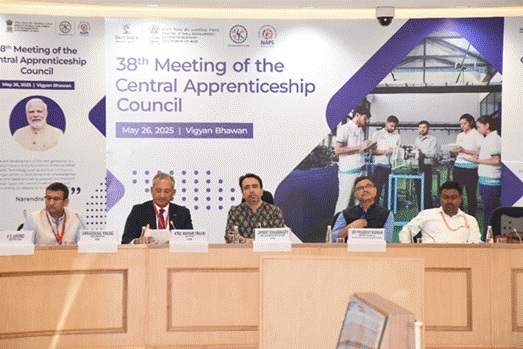National Apprenticeship Promotion and Training Schemes

- 28 May 2025
In News:
Recently, the 38th Meeting of the Central Apprenticeship Council (CAC), chaired by the Minister of State (Independent Charge) for the Ministry of Skill Development and Entrepreneurship (MSDE), recommended a 36% increase in stipends under two key skilling initiatives—National Apprenticeship Promotion Scheme (NAPS) and National Apprenticeship Training Scheme (NATS). This move aims to enhance apprenticeship attractiveness, reduce dropout rates, and improve youth employability across India.
About NAPS (Launched: 19 August 2016)
- Objective: To build industry-relevant skilled manpower by promoting on-the-job training and bridging the gap between education and employment.
- Administered by: Ministry of Skill Development and Entrepreneurship (MSDE).
- Key Features:
- Provides financial support to establishments for engaging apprentices.
- Encourages MSME participation and focuses on aspirational districts and the North-East.
- Offers partial stipend reimbursement under the Apprentices Act, 1961.
- Apprentices receive a certificate from NAPS, enhancing employability.
- Over 43.47 lakh apprentices engaged across 36 States/UTs till May 2025.
- Female participation reached 20%, with efforts to boost inclusion.
About NATS
- Target Group: Graduates, Diploma holders, and Vocational certificate holders.
- Provisions:
- Offers 6–12 months of practical, hands-on training.
- Employers receive 50% stipend reimbursement.
- Apprentices are issued a Government of India Certificate of Proficiency, valid across employment exchanges.
- FY 2024–25 Stats: Over 5.23 lakh apprentices enrolled.
Key Reforms Recommended by CAC (2025)
- Stipend Enhancement:
- Proposed increase from ?5,000–?9,000 to ?6,800–?12,300.
- To be adjusted biennially based on Consumer Price Index (CPI).
- Inclusive Skilling Framework:
- Definition of “Person with Benchmark Disability” to be added under the Apprenticeship Rules.
- Trades must indicate suitability for PwBDs with reserved training slots.
- Curricular Integration:
- Push for Degree Apprenticeships and Apprenticeship Embedded Degree Programmes (AEDP).
- Definitions added for "Institution", "UGC", and "Contractual Staff".
- Flexible Training Modes: Employers may provide Basic and Practical Training through online, virtual, or blended modes, adhering to standard curricula.
- Decentralized Administration: Proposal to establish Regional Boards to improve scheme outreach and governance.
- Sectoral Expansion:
- Adoption of NIC Code 2008 to replace outdated 1987 list.
- Brings emerging sectors like IT, software, telecom, biotech, and renewable energy under apprenticeship coverage.
- Operational Improvements:
- Align CTS (Craftsmen Training Scheme) courses with apprenticeship notification timelines.
- Consideration of location-based stipend rationalization based on cost of living.
- Proposal for insurance coverage for apprentices during contract periods.
Governance and Stakeholder Involvement
The Central Apprenticeship Council includes representatives from:
- Ministries: Education, Labour, MSME, Railways, Textiles.
- Industry: BHEL, Indian Oil, Tata, Maruti, Reliance.
- Institutions: NSDC, UGC, AICTE.
- State advisors and domain experts from labour and education fields.
